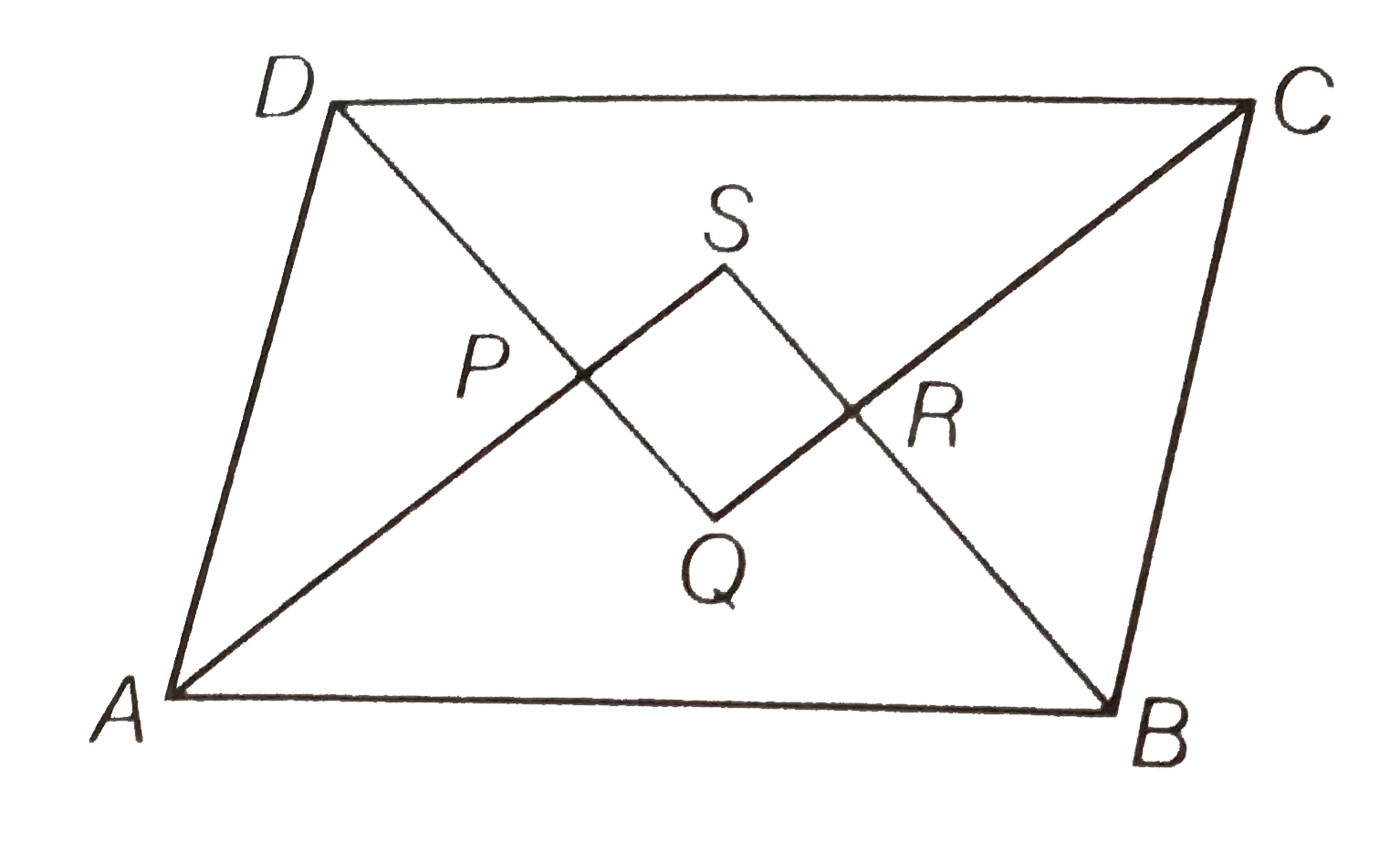If AP and BP are the bisectors of the angle A and angle B of a parallelogram ABCD, then value of the angle APB is
30∘
45∘
60∘
90∘
The correct Answer is:D
To find the value of angle APB in the given parallelogram ABCD, where AP and BP are the angle bisectors of angles A and B respectively, we can follow these steps:
1. Understanding the Properties of a Parallelogram:
- In a parallelogram, opposite angles are equal, and adjacent angles are supplementary. Therefore, if angle A is denoted as ∠A and angle B as ∠B, we have:
∠A+∠B=180∘
2. Using the Angle Bisector Theorem:
- Since AP is the bisector of angle A, we can express angle A as:
∠A=2×∠1
where ∠1 is half of angle A.
- Similarly, since BP is the bisector of angle B, we can express angle B as:
∠B=2×∠2
where ∠2 is half of angle B.
3. Setting Up the Equation:
- From the property of the parallelogram, we know:
∠A+∠B=180∘⟹2∠1+2∠2=180∘
- Dividing the entire equation by 2 gives:
∠1+∠2=90∘(Equation 1)
4. Analyzing Triangle APB:
- In triangle APB, we apply the angle sum property, which states that the sum of the angles in a triangle is 180 degrees:
∠1+∠2+∠APB=180∘
5. Substituting Equation 1 into the Triangle Equation:
- We already established that ∠1 + ∠2 = 90° from Equation 1. Substituting this into the triangle equation gives:
90∘+∠APB=180∘
6. Solving for Angle APB:
- To find ∠APB, we rearrange the equation:
∠APB=180∘−90∘=90∘
Conclusion:
Thus, the value of angle APB is:
90∘
- In a parallelogram, opposite angles are equal, and adjacent angles are supplementary. Therefore, if angle A is denoted as ∠A and angle B as ∠B, we have:
∠A+∠B=180∘
- Since AP is the bisector of angle A, we can express angle A as:
∠A=2×∠1
where ∠1 is half of angle A.
- Similarly, since BP is the bisector of angle B, we can express angle B as:
∠B=2×∠2
where ∠2 is half of angle B.
- From the property of the parallelogram, we know:
∠A+∠B=180∘⟹2∠1+2∠2=180∘
- Dividing the entire equation by 2 gives:
∠1+∠2=90∘(Equation 1)
- In triangle APB, we apply the angle sum property, which states that the sum of the angles in a triangle is 180 degrees:
∠1+∠2+∠APB=180∘
- We already established that ∠1 + ∠2 = 90° from Equation 1. Substituting this into the triangle equation gives:
90∘+∠APB=180∘
- To find ∠APB, we rearrange the equation:
∠APB=180∘−90∘=90∘
Thus, the value of angle APB is:
90∘
Topper's Solved these Questions
- BOOK - MTG IIT JEE FOUNDATIONCHAPTER - QUADRILATERALS EXERCISE - EXERCISE (Integer/Numerical Value Type)10videos
QUADRILATERALS
- BOOK - MTG IIT JEE FOUNDATIONCHAPTER - PROBABILITYEXERCISE - OLYMPIAD/HOTS CORNER20videos
PROBABILITY
- BOOK - MTG IIT JEE FOUNDATIONCHAPTER - STATISTICSEXERCISE - Olympiad/HOTS Corner20videos
STATISTICS
Similar Questions
Knowledge Check
- Question 1 - Select One
The bisector of the angles of a parallelogram enclose a
ArectangleBrhombusCsquareDtrapezium - Question 2 - Select One
If the bisector of the angles A and B of a quadrilateral ABCD meet at O, then ∠AOB is equal to:
A∠C+∠DB12(∠C+∠D)C12∠C+13∠DD13∠C+12∠D - Question 3 - Select One
The bisectors of any two adjacent angles of a parallelogram intersect at
A30∘B45∘C60∘D90∘
Shape made by the bisectors of angles of a parallelogram is
View SolutionFind the angles of the parallelogram ABCD if ∠C=23∠D.
View SolutionΔABC ,angle B external angle C meets at P ∠A=80 then ∠BPC = ?
View SolutionIn a quadrilateral ABCD, ∠D=60∘and∠C=100∘ . The bisectors of ∠Aand∠B meet at the point P. The measure of ∠APB is
View SolutionIn a quadrilateral ABCD,∠D=60∘and∠C=100∘. The bisectors of ∠Aand∠B meet at the point P. The measure of ∠APB is
View Solution


